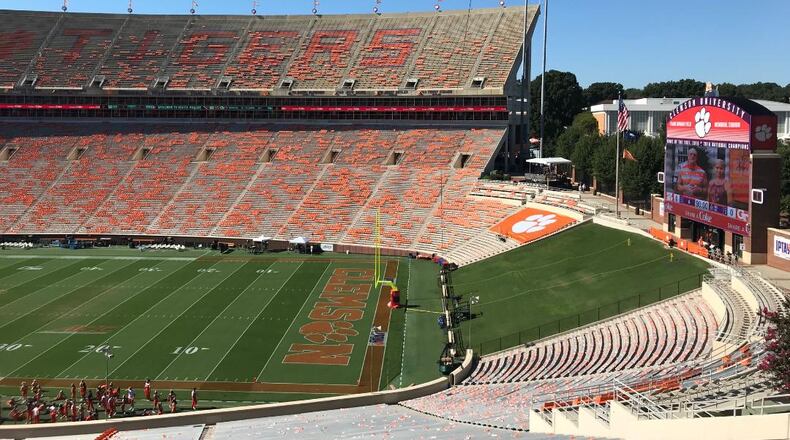My first sight of Clemson – the town, not the team – came Sept. 30, 1982. (I remember that time well. I got married nine days later.) I’d driven south from Lexington, hanging at Travelers Rest, in advance of Kentucky’s game with the Tigers, who happened to be defending a national championship.
My tour guide was the sainted Bob Bradley, the late Clemson publicist for whom the press box I now occupy is named. We were, as best we could figure, not related. I always hated that. I’d have loved to be able to call him Uncle Bob. But I digress.
The first story he told me about Clemson – the town, not the team – involved Bob Hope. (The actor/comedian, not the Atlanta publicist.) Seems Clemson had lured Mr. Hollywood to Littlejohn Coliseum to do a show, and Frank Howard – once the football coach, then the AD – decided to show the honored guest around.
They drove a couple of minutes. Said Hope: “Hey, Frank. When do we get to Clemson?”
Said Howard: “You want me to back up and show you again?”
I laughed hard at that. I laughed hard at everything Mr. Bradley said. He showed me Howard’s Rock, the unlikely touchstone that I thought bore a resemblance to E.T.’s head. He took me to practice and introduced me to Danny Ford. (Those practice fields remain the greenest I’ve seen.) He brought William Perry up to the sports information office for a one-on-one. The Refrigerator fit through the door, if only just. I laughed at everything he said, too, including this: “Even when I was little, I was big.”
The game itself was, as happened often with UK games of that vintage, nothing special. The Tigers won 24-6, the only news coming when Homer Jordan of Athens, the quarterback who led Clemson to its 1981 national championship, didn’t play. Seemed the NCAA had some questions about the provenance of his car. Seemed the Tigers’ sudden rise had caught the eye of the NCAA.
Come November, Clemson was hit with a two-year TV and postseason ban and docked 20 scholarships, then a record total. As a working reporter, I shouldn’t have cared. As someone who’d been taken with everything about Clemson – all who attended our wedding got the rundown on my conversation with the Fridge – I kind of hated it. Clemson was about the coolest place I’d ever seen.
Thirty-seven years later, Clemson is cool but also hot. It’s the best program in college football, Alabama included. In no time flat, the Tigers replaced the greatest player in school history – Deshaun Watson of Gainesville – with Trevor Lawrence of Cartersville, who might be even better. This isn’t to suggest that the Tigers didn’t play good football before 1981, but that title was a surprise. (They’d gone 6-5 in 1980.) After the sanctions, Clemson would go 31 years without being ranked higher than No. 8 in the final Associated Press poll.
Now, however, the Tigers look set to win forever. (OK, forever’s a long time. File that one under “slight hyperbole.”) Unless Dabo Swinney leaves to replace Nick Saban in Tuscaloosa, there would appear no halting this orange rush. Swinney is 49. He has taken Clemson to the playoff four years running. He has won it twice. He has a softer league than the SEC, and he has blown away the Tigers’ inherent of being based in a small state by grabbing recruits from everywhere, Georgia especially. Indeed, Clemson’s still-forming 2020 class is being hailed as the program’s greatest.
In the early ’80s, Clemson felt small – there really isn’t much to the town apart from the university – and cuddly. No matter how Swinney seeks to charactize his program as “little ol’ Clemson,” his creation is massive and voracious.
His athletic director is Dan Radakovich, formerly of Georgia Tech, and this is among the great coach/GM marriages in collegiate annals. D-Rad always wanted to be able to spend big to win big; Dabo maximizes every resource. And, unlike the assistants at Alabama, Clemson’s stay. Defensive coordinator Brent Venables has been in place since 2012; offensive coordinator Tony Elliott has been here since 2011.
When you come to Clemson now, there’s nothing to discover. The Tigers have spent the last four years making themselves known to the outside world. And still it’s remarkable: You can be within three miles of the massive Memorial Stadium, colloquially known as Death Valley, and still be driving on a country road. (Thanks to Waze, I just did.)
As the Tech All-American Ken Swilling -- who grew up just down the road in Toccoa -- said of playing in Death Valley: “You look up and go, ‘Where’d all these people come from?’”
About the Author
The Latest
Featured


